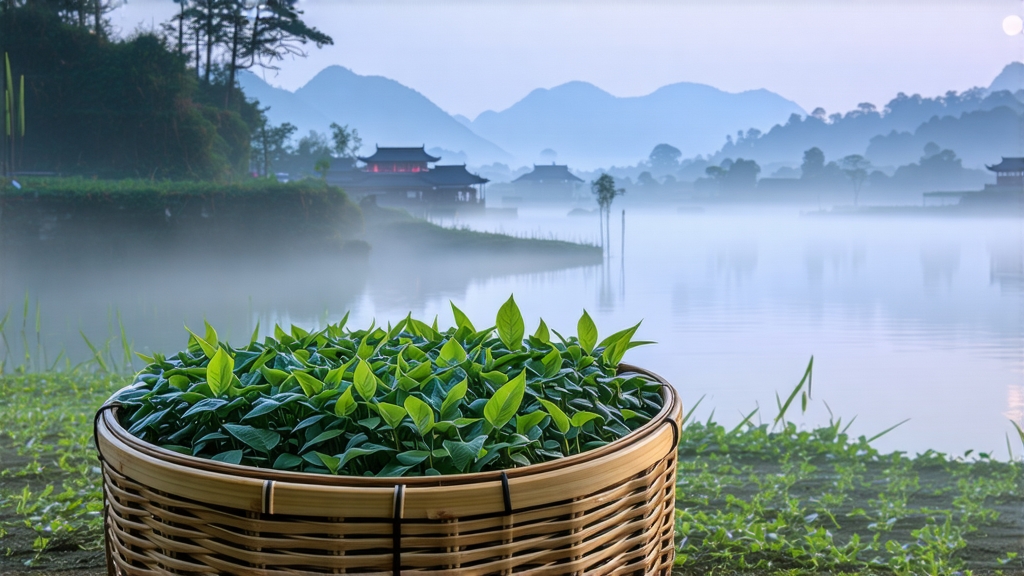
Longjing, literally “Dragon-Well,” is more than a tea; it is a liquid snapshot of Chinese springtime, a cultural emblem that has perfumed the hills around Hangzhou’s West Lake for well over a millennium. To understand Longjing is to trace the footsteps of Song-dynasty poets, Ming-dynasty emperors, and modern tea scientists who have all tried to capture its elusive, chestnut-sweet aroma. This article invites international tea lovers to explore the history, micro-ecology, craftsmanship, and sensory ritual that elevate one green tea above all others in the Chinese imagination.
Historical roots
The first reliable mention appears in Lu Yu’s Classic of Tea (760 CE), which lists a tea from “Qiantian” that scholars identify as present-day Xihu District. By the late Song era, monks at the Yongfu Temple were already pressing leaves into cakes for tribute, but the leaf style we recognize today—flat, jade-green spears—emerged during the early Ming, when the Hongwu Emperor abolished compressed tea and demanded loose leaf. The Kangxi Emperor (r. 1661-1722) famously granted imperial status to eighteen bushes in front of Lion Peak, an honor that still shapes pricing and prestige. In 1949, Longjing was served to Mao Zedong’s guests at the founding ceremony of the People’s Republic, sealing its role as diplomatic nectar; Nixon’s 1972 cup helped thaw the Cold War. Thus, every sip carries political memory as well as floral sweetness.
Terroir and micro-climates
West Lake is a drowned river valley whose granite slopes drain quickly, forcing roots to dive deep for mineral-rich water. Frequent mist filters harsh sunlight, preserving amino acids that translate into umami. The highest grade, Shifeng (Lion Peak), sits at 300 m on weathered quartzite; the air here is laced with apricot blossom and bamboo leaf volatiles that migrate into the tea. Longjing village itself is warmer; Mei-jia-wu is cooler and more humid, yielding a grassier profile. Across the lake, Weng-jia-shan receives reflected light that accelerates photosynthesis, creating a brighter, slightly astringent cup. These micro-zones are protected by a 2001 geographical indication law that limits acreage to 1,680 hectares, smaller than many Bordeaux châteaux.
Cultivars and picking calendar
The indigenous群体种 qunti-zhong, a seed-propagated landrace, remains the benchmark for complexity, but clonal selections such as Longjing #43 ripen seven days earlier and offer a more uniform leaf. Breeders at the Tea Research Institute have also released Zhong-te-108, prized for frost resistance and mango-like top notes. Picking begins when the air temperature holds steady at 10 °C for three consecutive days, usually between 15 March and 10 April. Only the standard “one bud with one unfolding leaf” (about 2.5 cm) is accepted; the bud must feel velvety, the leaf soft enough to bend without snapping. Experienced pickers finish 1 kg of fresh leaf in four hours—enough for 200 g of finished tea—earning piece-rate wages that exceed factory work.
The ten-step pan-firing choreography
Within four hours of plucking, the leaf is spread 3 cm thick on bamboo trays to wither for two hours, losing 10 % moisture and grassy edge. The critical kill-green phase uses a bare cast-iron wok heated to 80 °C. The master presses the leaf against the surface with bare hands, a technique called “grasp, shake, rub, fling” (抓、抖、搭、甩). Temperature is modulated by feel: too hot and amino acids caramelize; too cool and enzymes survive, dulling color. After ten minutes the leaf is removed, allowed to rehydrate for forty minutes, then returned to the wok at 60 °C for the “final shaping.” Here the operator’s wrists coax each bud into the signature flat spear, 25 mm long and 2 mm wide, smooth enough to stand on edge when dropped into a glass. Total firing time is 25 minutes; moisture drops to 6 %. The tea rests for two weeks in lime-lined earthen jars, allowing residual heat to dissipate while the lime absorbs stray odors.
Chemical signature
High-performance liquid chromatography reveals 4.2 % L-theanine, almost double that of sencha, explaining the brothy sweetness. Catechins hover at 14 %, balanced so that astringency arrives